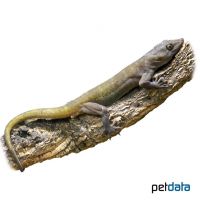Golden Gecko (Gekko badenii)
| Golden Gecko Gekko badenii | |
|---|---|
| Name | Golden Gecko |
| Name Lat. | Gekko badenii |
| Synonym | Gekko ulikovskii |
| Family | Geckos |
| Family lat. | Gekkonidae |
| Order | Scaled Reptiles |
| Order lat. | Squamata |
| Origin | Southeast Asia |
| Habitat | Rainforests |
| Diet | Insects, fruits |
| Humidity | 70-90 % |
| Behavior | Nocturnal; ♂ territorial |
| Keeping | Pair, harem |
| Care Level | Moderate |
| Reproduction | Oviparous |
| Housing | Humid terrarium |
| Life Span | 8-10 years |
| Protection | No |
| Metric Units | |
| Size | 18-20 cm |
| Temperature | 25-28 °C |
| Temperature Local | 35 °C |
| Housing Size | 70 x 70 x 100 cm |
| US Units | |
| Size | 7.1"-7.9" |
| Temperature | 77-82 °F |
| Temperature Local | 95 °F |
| Housing Size | 30" x 30" x 40" |
Distribution and habitat
The crepuscular and nocturnal golden geckos are native to the rainforests of Vietnam, near the border with Cambodia and Laos. They live mostly on trees and often use rock crevices as hiding places, but can also be found as cultural successors in settlements.
Maintenance
Minimum dimensions for the terrarium, according to the size and number of animals
| 1-2 animals | 6KRL x 6KRL x 8KRL (L x W x H) |
Head-torso length (KRL) is measured on the largest animal. For each additional animal, increase the footprint by 15%. A terrarium of e.g. 70 x 70 x 100 cm is recommended, which should be placed in a quiet and vibration-free place
You need a terrarium with strong climbing branches, many plants (ficus, ferns, mosses, epiphytes, etc.), rock formations (hiding places and privacy screens), structured back and side walls (e.g. cork lining) and a substrate of forest soil-peat mixture as well as a large water basin (waterfall). Several times a day the inside of the terrarium should be finely sprayed with water (humidity), but a rain or mist system is better
| Temp. day: 25-28 °C | Temp. night: 20-22 °C | Temp. local: up to 35 °C | Humidity: 70-90 % |
Thermostatically controlled floor heating is recommended. Lighting duration must be 12-14 hrs. Daylight fluorescent tubes are ideal. A special UV light is not necessary.
Diet
The diet consists of live insects, such as crickets, house crickets, grasshoppers, cockroaches, zophobas and mealybug larvae, supplemented with some fruit pulp and sweet fruits (e.g. bananas, papaya). Alternatively, special ready-made food for geckos or insectivorous reptiles can be offered. Wax moths should rarely be fed in very small amounts due to their large fat content. Young animals should be offered food daily, adults 4-5 times a week. Regular addition of minerals and vitamins (dusting of feed) is important. Drinking water must always be available, but is preferably taken in drop form from leaves or furnishings
A regular and varied diet promotes health and prevents deficiency symptoms.
Reproduction and breeding
The adult male has a thickened caudal root with a distinct hemipenis pouch and a spur on either side of the cloacal opening.
The female sticks her hard-shelled eggs (2 pieces) to the decoration several times a year. At a temperature of 25-30 °C the incubation period is 65-100 days. There is no brood care. Small insects such as fruit flies and micro echinoderms are suitable as initial food for the young.
The life expectancy can be 8-10 years.
Important
With their lamellar toes (adhesive toes) they can also climb on smooth, vertical surfaces (e.g. glass).
Adult males are very territorial and incompatible with each other. However, they can be well maintained in a group, one male with several females
For the resting phase, shorten the lighting duration by 2-3 hours and lower the temperature by 3-4 °C for about two months
With fruit and honey water as food for the feeders, their quality can be upgraded.
The terrarium must have good ventilation without drafts and meet the species specific needs. Measuring devices such as thermometers, hygrometers, etc. are necessary. The lighting has to correspond to the species-specific day-night rhythm and has to be placed in such a way that the animals cannot injure themselves. The terrarium should be locked in such a way that neither unauthorized persons can open it nor the animals can escape. Contamination must be removed regularly.
Further literature can be found in your pet store.
References
Text: petdata; Image: petdata
Source: BMELV (1997): Tierschutzgutachten - Mindestanforderungen an die Haltung von Reptilien; ENGELMANN (2006): Zootierhaltung - Tiere in menschlicher Obhut: Reptilien und Amphibien, Harri Deutsch Verlag
- Gemäß § 21 Abs. 5 Tierschutzgesetz idgF
